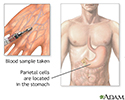Antiparietal cell antibody test
APCA; Anti-gastric parietal cell antibody; Atrophic gastritis - anti-gastric parietal cell antibody; Gastric ulcer - anti-gastric parietal cell antibody; Pernicious anemia - anti-gastric parietal cell antibody; Vitamin B12 - anti-gastric parietal cell antibody
An antiparietal cell antibody test is a blood test that looks for antibodies against the parietal cells of the stomach. The parietal cells make and release a substance that the body needs to absorb vitamin B12.
Antibodies
An antibody is a protein produced by the body's immune system when it detects harmful substances, called antigens. Examples of antigens include micr...

How the Test is Performed
A blood sample is needed.
Blood sample
Venipuncture is the collection of blood from a vein. It is most often done for laboratory testing.

How to Prepare for the Test
No special preparation is necessary.
How the Test will Feel
When the needle is inserted to draw blood, some people feel moderate pain. Others feel only a prick or stinging. Afterward, there may be some throbbing or slight bruising. This soon goes away.
Why the Test is Performed
Your health care provider may use this test to help diagnose pernicious anemia. Pernicious anemia is a decrease in red blood cells that occurs when your intestines cannot properly absorb vitamin B12. Other tests are also used to help with the diagnosis.
Pernicious anemia
Anemia is a condition in which the body does not have enough healthy red blood cells. Red blood cells provide oxygen to body tissues. There are man...

Normal Results
A normal result is called a negative result.
Normal value ranges may vary slightly among different laboratories. Some labs use different measurements or test different samples. Talk to your provider about the meaning of your specific test results.
What Abnormal Results Mean
An abnormal result is called a positive result. This may be due to:
-
Atrophic
gastritis
(inflammation of the stomach lining)
Gastritis
Gastritis occurs when the lining of the stomach becomes inflamed or swollen. Gastritis can last for only a short time (acute gastritis). It may als...
 ImageRead Article Now Book Mark Article
ImageRead Article Now Book Mark Article -
Diabetes
Diabetes
Diabetes is a chronic disease in which the body cannot regulate the amount of sugar in the blood.
 ImageRead Article Now Book Mark Article
ImageRead Article Now Book Mark Article -
Gastric ulcer
Gastric ulcer
A peptic ulcer is an open sore or raw area in the lining of the stomach or intestine. A gastric ulcer occurs in the stomach. A duodenal ulcer occurs ...
 ImageRead Article Now Book Mark Article
ImageRead Article Now Book Mark Article -
Pernicious anemia
Pernicious anemia
Anemia is a condition in which the body does not have enough healthy red blood cells. Red blood cells provide oxygen to body tissues. There are man...
 ImageRead Article Now Book Mark Article
ImageRead Article Now Book Mark Article - Thyroid disease
Risks
Veins and arteries vary in size from one person to another and from one side of the body to the other. Obtaining a blood sample from some people may be more difficult than from others.
Other risks associated with having blood drawn are slight, but may include:
- Excessive bleeding
- Fainting or feeling lightheaded
- Hematoma (blood buildup under the skin)
- Infection (a slight risk any time the skin is broken)
References
Ferri FF. Pernicious anemia. In: Ferri FF, ed. Ferri's Clinical Advisor 2016 . Philadelphia, PA: Elsevier; 2016:section I.
Hogenauer C, Hammer HF. Maldigestion and malabsorption. In: Feldman M, Friedman LS, Brandt LJ, eds. Sleisenger and Fordtran's Gastrointestinal and Liver Disease . 10th ed. Philadelphia, PA: Elsevier Saunders; 2016:chap 104.
-
Antiparietal cell antibodies - illustration
Antiparietal cell antibodies is a test that measures the presence of antibodies against gastric parietal cells. Ninety percent of people with pernicious anemia test positive for antiparietal cell antibodies.
Antiparietal cell antibodies
illustration
Review Date: 2/11/2016
Reviewed By: Todd Gersten, MD, Hematology/Oncology, Florida Cancer Specialists & Research Institute, Wellington, FL. Review provided by VeriMed Healthcare Network. Also reviewed by David Zieve, MD, MHA, Isla Ogilvie, PhD, and the A.D.A.M. Editorial team.

